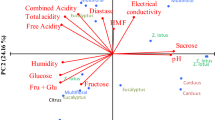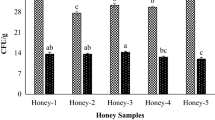Abstract
Honey is a traditional food used by humans due to many therapeutic properties. Turkey is in a good position for the production of bee products, and honey is the most popular bee product in the country. In this study, the aim was to evaluate the quality parameters of 40 honey samples based on physicochemical parameters and to gain information about speed of crystallization. For this purpose, moisture (%), fructose (%), glucose (%), fructose + glucose (F + G, %), fructose/glucose (F/G), glucose/moisture (G/M), and proline (mg/kg) contents were determined in honey samples and cluster analysis was performed. When the sugar profile of honey samples is examined, F + G was 61.63–78.03%, F/G was 0.99–1.25, moisture content was 14.9–19.1%, and proline content was 384.41–1271.56 mg/kg. These results comply with national standards. Honey samples tend to crystallize quickly when their crystallization properties are evaluated based on F/G and G/M ratios. Consequently, the quality of honey differs according to the region from which it is produced and it is natural for honey to crystallize.




Similar content being viewed by others
Data availability
The data that support the findings of this study are available from the corresponding author upon reasonable request.
References
Anklam E (1998) A review of the analytical methods to determine the geographical and botanical origin of honey. Food Chem 63:549–562. https://doi.org/10.1016/s0308-8146(98)00057-0
Bayram N, Yüzer MO, Bayram S (2019) Melissopalynology analysis, physicochemical properties, multi-element content and antimicrobial activity of honey samples collected from Bayburt, Turkey. Uludağ Bee J 19:161–176
Bergamo G, Seraglio SKT, Gonzaga LV, Fett R, Costa ACO (2019) Physicochemical characteristics of bracatinga honeydew honey and blossom honey produced in the state of Santa Catarina: an approach to honey differentiation. Int Food Res J 116:745–754. https://doi.org/10.1016/j.foodres.2018.09.007
Bogdanov S, Ruoff K, Oddo LP (2004) Physico-chemical methods for the characterisation of unifloral honeys: a review. Apidologie 35(1):4–17. https://doi.org/10.1051/apido:2004047
Bouhlali EDT, Bammou M, Sellam K, El Midaoui A, Bourkhis B, Ennassir J, Alem C, Filali-Zegzouti Y (2019) Physicochemical properties of eleven monofloral honey samples produced in Morocco. Arab J Basic Appl Sci 26(1):476–487. https://doi.org/10.1080/25765299.2019.1687119
Bruni I, Galimberti A, Caridi L, Scaccabarozzi D, De Mattia F, Casiraghi M, Labra M (2015) A DNA barcoding approach to identify plant species in multiflower honey. Food Chem 170:308–315. https://doi.org/10.1016/j.foodchem.2014.08.060
Can Z, Yildiz O, Sahin H, Turumtay EA, Silici S, Kolayli S (2015) An investigation of Turkish honeys: their physico-chemical properties, antioxidant capacities and phenolic profiles. Food Chem 180:133–141. https://doi.org/10.1016/j.foodchem.2015.02.024
Codex Alimentarius Commission (2001) Revised codex standard for honey. Codex Standard 12–1981. FAO and WHO, Rome
Cotte JF, Casabianca H, Chardon S, Lheritier J, Grenier-Loustalot MF (2003) Application of carbohydrate analysis to verify honey authenticity. J Chromatogr A 1021(1–2):145–155. https://doi.org/10.1016/j.chroma.2003.09.005
Cuevas-Glory LF, Pino JA, Santiago LS, Sauri-Duch E (2007) A review of volatile analytical methods for determining the botanical origin of honey. Food Chem 103(3):1032–1043. https://doi.org/10.1016/j.foodchem.2006.07.068
da Silva PM, Gauche C, Gonzaga LV, Costa ACO, Fett R (2016) Honey: chemical composition, stability and authenticity. Food Chem 196:309–323. https://doi.org/10.1016/j.foodchem.2015.09.051
Dobre I, Georgescu LA, Alexe P, Escuredo O, Seijo MC (2012) Rheological behavior of different honey types from Romania. Food Res Int 49(1):126–132. https://doi.org/10.1016/j.foodres.2012.08.009
Dyce EJ (1975) Producing finely granulated or creamed honey. In: Crane E (ed) Honey—a comprehensive survey. Heinemann, London, pp 293–306
Ecem Bayram N, Gerçek YC, Bayram S, Toğar B (2020) Effects of processing methods and extraction solvents on the chemical content and bioactive properties of propolis. J Food Meas Charact 14:905–916. https://doi.org/10.1007/s11694-019-00340-z
Ecem Bayram N, Gerçek YC, Öz G (2020) Screening for antioxidant capacity, pollen types and phytochemical profile by GC/MS and UHPLC from propolis. Prog Nutr 22(3):1–10
Escuredo O, Dobre I, Fernández-González M, Seijo MC (2014) Contribution of botanical origin and sugar composition of honeys on the crystallization phenomenon. Food Chem 149:84–90. https://doi.org/10.1016/j.foodchem.2013.10.097
Finola MS, Lasagno MC, Marioli JM (2007) Microbiological and chemical characterization of honeys from central Argentina. Food Chem 100(4):1649–1653. https://doi.org/10.1016/j.foodchem.2005.12.046
Grégrová A, Kružík V, Vrácovská E, Rajchl A, Čížková H (2015) Evaluation of factors affecting crystallization of disparate set of multi-flower honey samples. Agron Res 13(5):1215–1226
Hermosı́n I, Chicon RM, Cabezudo MD (2003) Free amino acid composition and botanical origin of honey. Food Chem 83(2):263–268. https://doi.org/10.1016/s0308-8146(03)00089-x
International Honey Commission (IHC) (2009) Harmonised Methods of the International Honey Commission. http://www.ihc-platform.net/ihcmethods2009.pdf. Acessed 16 Jan 2020
Ji P, Liu X, Yang C, Wu F, Sun J, Cao W, Zhao H (2023) Natural crystallization properties of honey and seed crystals-induced crystallization process for honey performance enhancing. Food Chem 405:134972. https://doi.org/10.1016/j.foodchem.2022.134972
Kaplan M, Karaoglu Ö, Eroglu N, Silici S (2016) Fatty acid and proximate composition of bee bread. Food Technol Biotechnol 54(4):497–504
Kaškonienė V, Venskutonis PR, Čeksterytė V (2010) Carbohydrate composition and electrical conductivity of different origin honeys from Lithuania. LWT Food Sci Technol 43(5):801–807. https://doi.org/10.1016/j.lwt.2010.01.007
Keskin M, Kolaylı S (2019) Ticari propolis ekstraktlarının kalite parametreleri açısından karşılaştırılması. Uludag Bee J 19(1):43–49
Manikis I, Thrasivoulou A (2001) The relation of physicochemical characteristics of honey and the crystallization sensitive parameters. Apiacta 36(2):106–112
Mayda N, Özkök A, Sorkun K (2018) Some characteristic properties of chestnut and rhododendron honeys in Turkey. Hacettepe J Biol Chem 46(1):135–145
Nayik GA, Dar BN, Nanda V (2019) Physico-chemical, rheological and sugar profile of different unifloral honeys from Kashmir valley of India. Arab J Chem 12(8):3151–3162. https://doi.org/10.1016/j.arabjc.2015.08.017
Oddo LP, Bogdanov S (2004) Determination of honey botanical origin: problems and issues. Apidologie 35(1):2–3. https://doi.org/10.1051/apido:2004044
Oddo LP, Piro R, Bruneau É, Guyot-Declerck C, Ivanov T, Piskulová J, Ruoff K (2004) Main European unifloral honeys: descriptive sheets. Apidologie 35(1):38–81. https://doi.org/10.1051/apido:2004049
Overton SV, Manura JJ (1994) Flavor and aroma in commercial bee honey: a purge-and-trap thermal desorption technique for the identification and quantification of volatiles and semivolatiles in honey. Am Lab 26(6):45–45
Özkök D, Silici S (2018) Effects of crystallization on antioxidant property of honey. J Apither 3(2):24–30. https://doi.org/10.5455/ja.20180607113134
Pasias IN, Raptopoulou KG, Makrigennis G, Ntakoulas DD, Lembessis D, Dimakis V, Katsinas R, Proestos C (2022) Finding the optimum treatment procedure to delay honey crystallization without reducing its quality. Food Chem 381:132301. https://doi.org/10.1016/j.foodchem.2022.132301
Persano Oddo L, Piazza MG, Sabatini AG, Accorti M (1995) Characterization of unifloral honeys. Apidologie 26(6):453–465. https://doi.org/10.1051/apido:19950602
Radovic BS, Careri M, Mangia A, Musci M, Gerboles M, Anklam E (2001) Contribution of dynamic headspace GC–MS analysis of aroma compounds to authenticity testing of honey. Food Chem 72(4):511–520. https://doi.org/10.1016/s0308-8146(00)00263-6
Sakač MB, Jovanov PT, Marić AZ, Pezo LL, Kevrešan ŽS, Novaković AR, Nedeljković NM (2019) Physicochemical properties and mineral content of honey samples from Vojvodina (Republic of Serbia). Food Chem 276:15–21. https://doi.org/10.1016/j.foodchem.2018.09.149
Sanz ML, Gonzalez M, De Lorenzo C, Sanz J, Martınez-Castro I (2005) Acontribution to the differentiation between nectar honey and honeydew honey. Food Chem 91(2):313–317. https://doi.org/10.1016/j.foodchem.2004.06.013
Scholz MBDS, Quinhone Júnior A, Delamuta BH, Nakamura JM, Baudraz MC, Reis MO, Kato T, Pedrão MR, Bianchini FP, Dias LF, dos Santos DTR, Kitzberger CSG, Binachini FP (2020) Indication of the geographical origin of honey using its physicochemical characteristics and multivariate analysis. J Food Sci Technol 57(5):1896–1903. https://doi.org/10.1007/s13197-019-04225-3
Serra Bonvehi J (1988) Propriétés physico-chimiques, composition et spectre pollinique des miels de Lavandula latifolia Med produits en Espagne. Sci Des Alim 8(2):295–307
Singh I, Singh S (2018) Honey moisture reduction and its quality. J Food Sci Technol 55(10):3861–3871. https://doi.org/10.1007/s13197-018-3341-5
Smanalieva J, Senge B (2009) Analytical and rheological investigations into selected unifloral German honey. Eur Food Res Technol 229(1):107–113. https://doi.org/10.1007/s00217-009-1031-2
Sorkun K (2008) Türkiye’nin Nektarlı bitkileri, polenleri ve balları. Palme Publisher, Ankara, Türkiye
The Council of the European Union (2002) Council directive 2001/110/EC of 20 December 2001 relating to honey. Off J Eur Commun L10:47–52
Tosi EA, Ré E, Lucero H, Bulacio L (2004) Effect of honey high-temperature short-time heating on parameters related to quality, crystallisation phenomena and fungal inhibition. LWT Food Sci Technol 37(6):669–678. https://doi.org/10.1016/j.lwt.2004.02.005
Turkish Food Codex (2020) Turkish Food Codex Communiqué on Honey (No: 2020/7). https://www.resmigazete.gov.tr/eskiler/2020/04/20200422-13.htm. Accesed 20 Apr 2020
Venir E, Spaziani M, Maltini E (2010) Crystallization in “Tarassaco” Italian honey studied by DSC. Food Chem 122(2):410–415. https://doi.org/10.1016/j.foodchem.2009.04.012
Wen YQ, Zhang J, Li Y, Chen L, Zhao W, Zhou J, Jin Y (2017) Characterization of Chinese unifloral honeys based on proline and phenolic content as markers of botanical origin, using multivariate analysis. Molecules 22(5):735. https://doi.org/10.3390/molecules22050735
White JW Jr (1978) Honey, advances in food research, New York, San Francisco, vol 24. Board Academic Press, London, pp 287–374
White JW Jr (1980) Detection of honey adulteration by carbohydrate analysis. J Assoc Off Anal Chem 63(1):11–18. https://doi.org/10.1093/jaoac/63.1.11
Yücel B, Sahin H, Yıldız O, Kolaylı S (2019) Bioactive components and effect mechanism of Apilarnil. Hayvansal Üretim 60(2):125–130
Acknowledgements
The authors would like to thank Tokat Beekeepers’ Association for honey samples.
Author information
Authors and Affiliations
Corresponding author
Ethics declarations
Conflict of interest
There are no conficts to declare.
Compliance with ethics requirements
This article does not contain any studies with human and animal subjects.
Additional information
Publisher's Note
Springer Nature remains neutral with regard to jurisdictional claims in published maps and institutional affiliations.
Rights and permissions
Springer Nature or its licensor (e.g. a society or other partner) holds exclusive rights to this article under a publishing agreement with the author(s) or other rightsholder(s); author self-archiving of the accepted manuscript version of this article is solely governed by the terms of such publishing agreement and applicable law.
About this article
Cite this article
Ecem Bayram, N. Nectar honey from Turkey: crystallization and physicochemical profile. Eur Food Res Technol 249, 1049–1057 (2023). https://doi.org/10.1007/s00217-022-04194-6
Received:
Revised:
Accepted:
Published:
Issue Date:
DOI: https://doi.org/10.1007/s00217-022-04194-6




